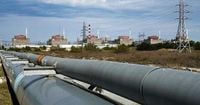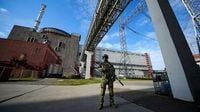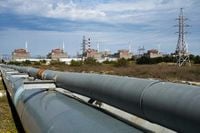For more than a week, the Zaporizhzhia Nuclear Power Plant in southern Ukraine has been plunged into an unprecedented crisis, cut off from the national electrical grid and forced to rely solely on emergency diesel generators. This marks the longest such outage since the start of Russia’s full-scale invasion in 2022, and both Ukrainian and international officials are sounding the alarm about the precariousness of the situation.
Ukrainian President Volodymyr Zelensky did not mince words in his evening address on September 30, 2025. "It is now the seventh day – by the way, it is something that has never happened before – of an emergency situation at the Zaporizhzhia Nuclear Power Plant. The situation is critical," he warned, according to The Kyiv Independent. The facility, located in the Russian-occupied city of Enerhodar on the Dnipro River, is Europe’s largest nuclear plant and sits dangerously close to the front lines of ongoing hostilities.
Since Russian strikes severed Zaporizhzhia’s external power lines, the plant has been running on backup diesel generators, which are designed as a last resort rather than a long-term solution. "The generators and the plant were not designed for this, and have never operated in this mode for so long. And we already have information that one generator has failed," Zelensky added, highlighting the mounting risk. The president accused Moscow of obstructing repairs by continuing to shell the area, stating, "And this is a threat to absolutely everyone. No terrorist in the world has ever dared to do to a nuclear plant what Russia is doing right now."
The six reactors at Zaporizhzhia have been shut down since Russian forces seized the plant in the early days of the invasion on February 24, 2022. However, the need for electricity remains: power is crucial to maintain cooling and prevent a catastrophic nuclear incident. The current crisis was triggered when the plant lost its last remaining off-site power line on September 23, 2025, after military activity damaged infrastructure about 1.5 kilometers from the facility, according to the International Atomic Energy Agency (IAEA).
Responsibility for the blackout is fiercely contested. Zelensky blames Russian artillery for damaging the power line, while Kremlin spokesman Dmitry Peskov insists it was Ukrainian shelling, remarking to reporters, "It is stupid to accuse the Russian side of shelling the plant it controls." This bitter dispute underscores the broader fog of war that has shrouded the Zaporizhzhia plant since it fell under Russian occupation. Ukraine has four nuclear plants, but Zaporizhzhia is the only one under Russian control.
The IAEA, the United Nations’ nuclear watchdog, has been monitoring the situation closely. Director General Rafael Grossi confirmed that there is no immediate danger as long as the emergency generators continue working, but he emphasized the unsustainability of the current arrangement. "While the plant is currently coping thanks to its emergency diesel generators – the last line of defence – and there is no immediate danger as long as they keep working, it is clearly not a sustainable situation in terms of nuclear safety," Grossi said in a statement. He added, "Nevertheless, it is extremely important that off-site power is restored."
An IAEA team on the ground reported that eight emergency diesel generators are currently operating, with nine more on standby and three under maintenance. Fuel reserves are sufficient to keep the generators running for more than 10 days, with regular off-site supplies helping to maintain this level. The plant’s administration, however, has told the IAEA that ongoing hostilities have made it impossible to carry out essential repairs to the damaged power lines.
The European Union has responded by calling on Russia to "immediately cease all military operations around the nuclear plant" and permit urgent repairs. In a statement on September 30, the EU’s diplomatic service denounced the Russian occupation of the plant as illegal and demanded Moscow withdraw its forces. The EU’s position reflects growing international concern about the potential for disaster at Zaporizhzhia, which is not only the largest nuclear facility in Europe but also ranks among the ten biggest in the world.
Since the beginning of the war, the Zaporizhzhia plant has faced a series of safety crises. There have been repeated power outages, shelling in the vicinity, and chronic staffing shortages as the conflict rages on. The plant lost off-site power for the tenth time during the war on September 23, 2025, a grim milestone that has only heightened fears of a nuclear catastrophe. "The current status of the reactor units and spent fuel is stable as long as the emergency diesel generators are able to provide sufficient power to maintain essential safety-related functions and cooling," Grossi explained, but he cautioned that the backup generators have never run for such an extended period before.
Efforts to resolve the crisis have so far been stymied by the ongoing fighting. Both Ukrainian and Russian officials, as well as the IAEA, have been in contact to try to restore off-site power, but the situation on the ground remains volatile and dangerous. The IAEA’s Grossi stated, "We are in constant contact with the two sides with the aim to enable the plant’s swift re-connection to the electricity grid." Still, as long as the conflict persists and the area around the plant remains a battleground, the risks are unlikely to subside.
For residents of Ukraine and neighboring countries, the crisis at Zaporizhzhia is a stark reminder of the dangers posed by war in the nuclear age. The prospect of a nuclear accident—whether caused by direct shelling, equipment failure, or a prolonged loss of power—looms over the region. The plant’s administration, the IAEA, and international leaders have all urged restraint, yet the fighting continues, and the clock keeps ticking on the diesel generators’ fuel reserves. As Zelensky put it, "This is a threat to absolutely everyone."
With the plant’s fate hanging in the balance, the world watches anxiously, hoping that diplomatic efforts and technical fixes can avert a disaster that would have consequences far beyond the borders of Ukraine.



